roof NISSAN ALTIMA 2022 Owners Manual
[x] Cancel search | Manufacturer: NISSAN, Model Year: 2022, Model line: ALTIMA, Model: NISSAN ALTIMA 2022Pages: 559, PDF Size: 6.26 MB
Page 77 of 559
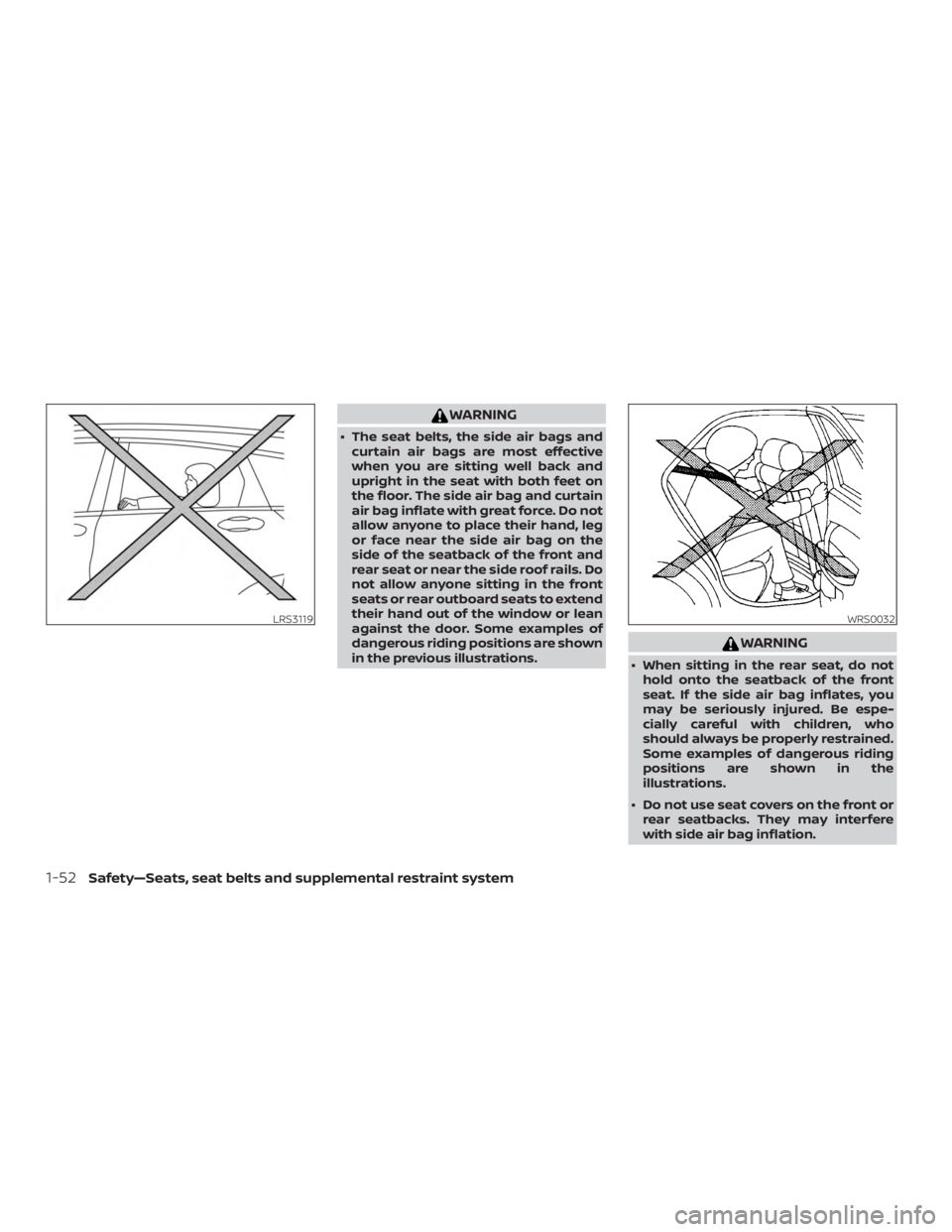
WARNING
∙ The seat belts, the side air bags andcurtain air bags are most effective
when you are sitting well back and
upright in the seat with both feet on
the floor. The side air bag and curtain
air bag inflate with great force. Do not
allow anyone to place their hand, leg
or face near the side air bag on the
side of the seatback of the front and
rear seat or near the side roof rails. Do
not allow anyone sitting in the front
seats or rear outboard seats to extend
their hand out of the window or lean
against the door. Some examples of
dangerous riding positions are shown
in the previous illustrations.
Page 87 of 559
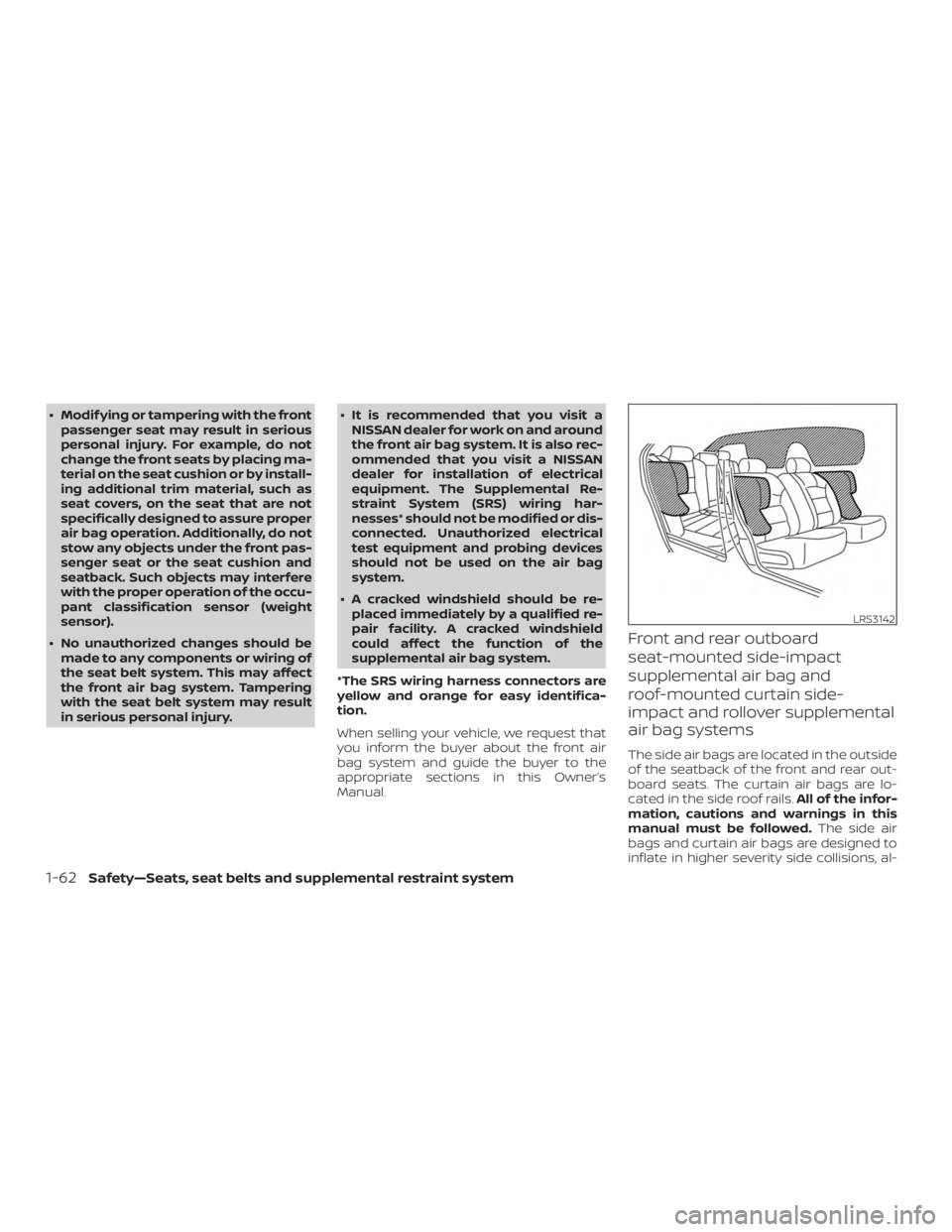
∙ Modif ying or tampering with the frontpassenger seat may result in serious
personal injury. For example, do not
change the front seats by placing ma-
terial on the seat cushion or by install-
ing additional trim material, such as
seat covers, on the seat that are not
specifically designed to assure proper
air bag operation. Additionally, do not
stow any objects under the front pas-
senger seat or the seat cushion and
seatback. Such objects may interfere
with the proper operation of the occu-
pant classification sensor (weight
sensor).
∙ No unauthorized changes should be made to any components or wiring of
the seat belt system. This may affect
the front air bag system. Tampering
with the seat belt system may result
in serious personal injury. ∙ It is recommended that you visit a
NISSAN dealer for work on and around
the front air bag system. It is also rec-
ommended that you visit a NISSAN
dealer for installation of electrical
equipment. The Supplemental Re-
straint System (SRS) wiring har-
nesses* should not be modified or dis-
connected. Unauthorized electrical
test equipment and probing devices
should not be used on the air bag
system.
∙ A cracked windshield should be re- placed immediately by a qualified re-
pair facility. A cracked windshield
could affect the function of the
supplemental air bag system.
*The SRS wiring harness connectors are
yellow and orange for easy identifica-
tion.
When selling your vehicle, we request that
you inform the buyer about the front air
bag system and guide the buyer to the
appropriate sections in this Owner’s
Manual.
Front and rear outboard
seat-mounted side-impact
supplemental air bag and
roof-mounted curtain side-
impact and rollover supplemental
air bag systems
The side air bags are located in the outside
of the seatback of the front and rear out-
board seats. The curtain air bags are lo-
cated in the side roof rails. All of the infor-
mation, cautions and warnings in this
manual must be followed. The side air
bags and curtain air bags are designed to
inflate in higher severity side collisions, al-
Page 88 of 559
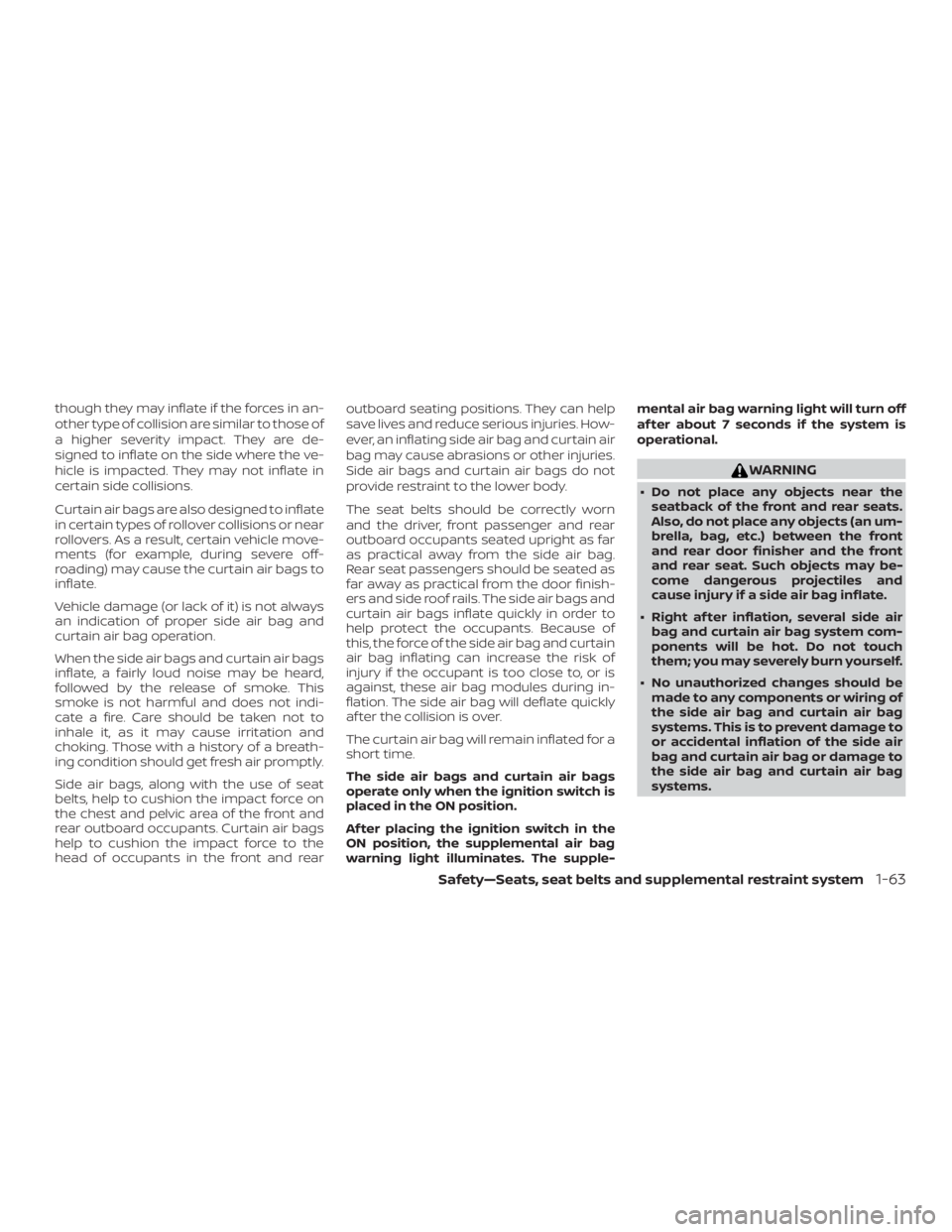
though they may inflate if the forces in an-
other type of collision are similar to those of
a higher severity impact. They are de-
signed to inflate on the side where the ve-
hicle is impacted. They may not inflate in
certain side collisions.
Curtain air bags are also designed to inflate
in certain types of rollover collisions or near
rollovers. As a result, certain vehicle move-
ments (for example, during severe off-
roading) may cause the curtain air bags to
inflate.
Vehicle damage (or lack of it) is not always
an indication of proper side air bag and
curtain air bag operation.
When the side air bags and curtain air bags
inflate, a fairly loud noise may be heard,
followed by the release of smoke. This
smoke is not harmful and does not indi-
cate a fire. Care should be taken not to
inhale it, as it may cause irritation and
choking. Those with a history of a breath-
ing condition should get fresh air promptly.
Side air bags, along with the use of seat
belts, help to cushion the impact force on
the chest and pelvic area of the front and
rear outboard occupants. Curtain air bags
help to cushion the impact force to the
head of occupants in the front and rearoutboard seating positions. They can help
save lives and reduce serious injuries. How-
ever, an inflating side air bag and curtain air
bag may cause abrasions or other injuries.
Side air bags and curtain air bags do not
provide restraint to the lower body.
The seat belts should be correctly worn
and the driver, front passenger and rear
outboard occupants seated upright as far
as practical away from the side air bag.
Rear seat passengers should be seated as
far away as practical from the door finish-
ers and side roof rails. The side air bags and
curtain air bags inflate quickly in order to
help protect the occupants. Because of
this, the force of the side air bag and curtain
air bag inflating can increase the risk of
injury if the occupant is too close to, or is
against, these air bag modules during in-
flation. The side air bag will deflate quickly
af ter the collision is over.
The curtain air bag will remain inflated for a
short time.
The side air bags and curtain air bags
operate only when the ignition switch is
placed in the ON position.
Af ter placing the ignition switch in the
ON position, the supplemental air bag
warning light illuminates. The supple-mental air bag warning light will turn off
af ter about 7 seconds if the system is
operational.
Page 160 of 559
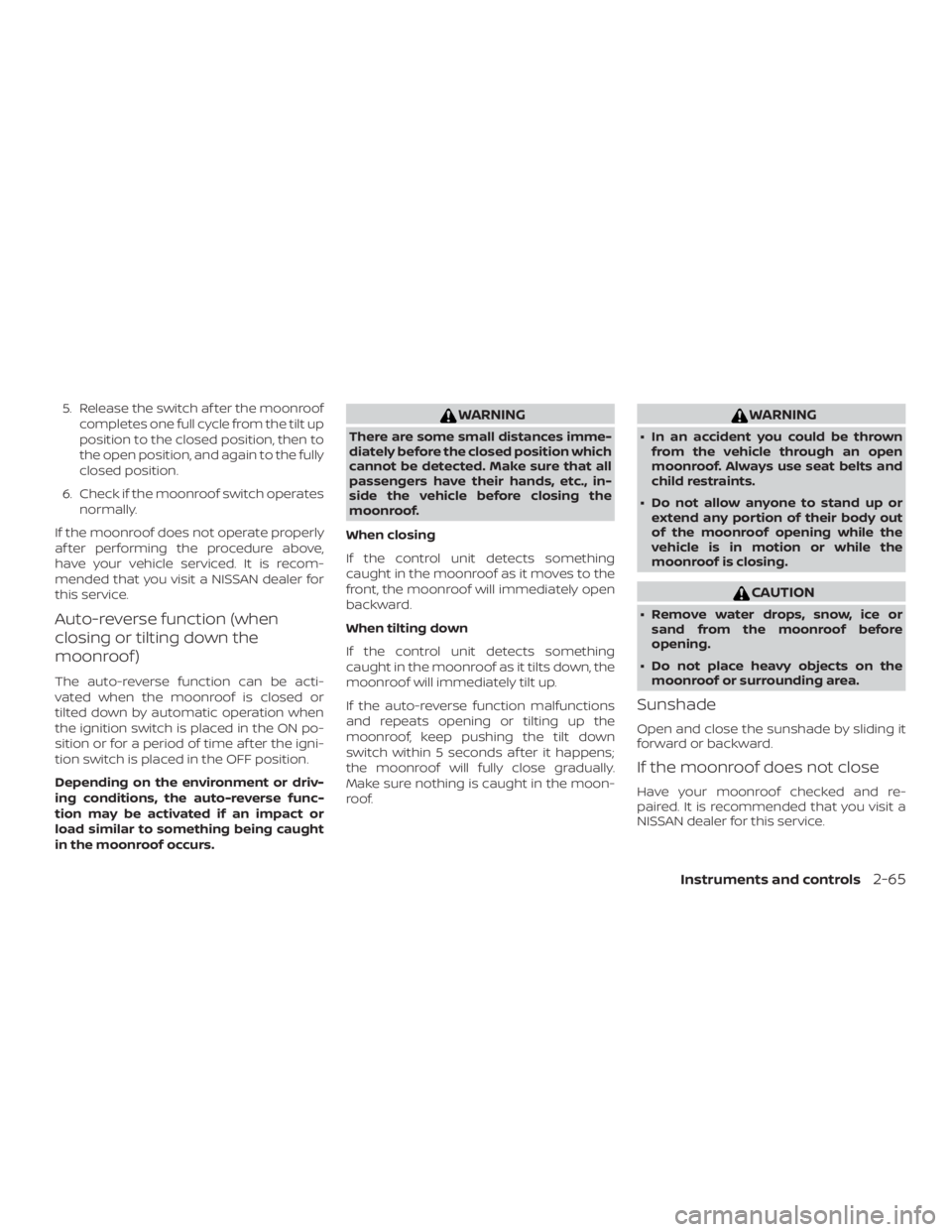
5. Release the switch af ter the moonroofcompletes one full cycle from the tilt up
position to the closed position, then to
the open position, and again to the fully
closed position.
6. Check if the moonroof switch operates normally.
If the moonroof does not operate properly
af ter performing the procedure above,
have your vehicle serviced. It is recom-
mended that you visit a NISSAN dealer for
this service.
Auto-reverse function (when
closing or tilting down the
moonroof )
The auto-reverse function can be acti-
vated when the moonroof is closed or
tilted down by automatic operation when
the ignition switch is placed in the ON po-
sition or for a period of time af ter the igni-
tion switch is placed in the OFF position.
Depending on the environment or driv-
ing conditions, the auto-reverse func-
tion may be activated if an impact or
load similar to something being caught
in the moonroof occurs.
Page 244 of 559
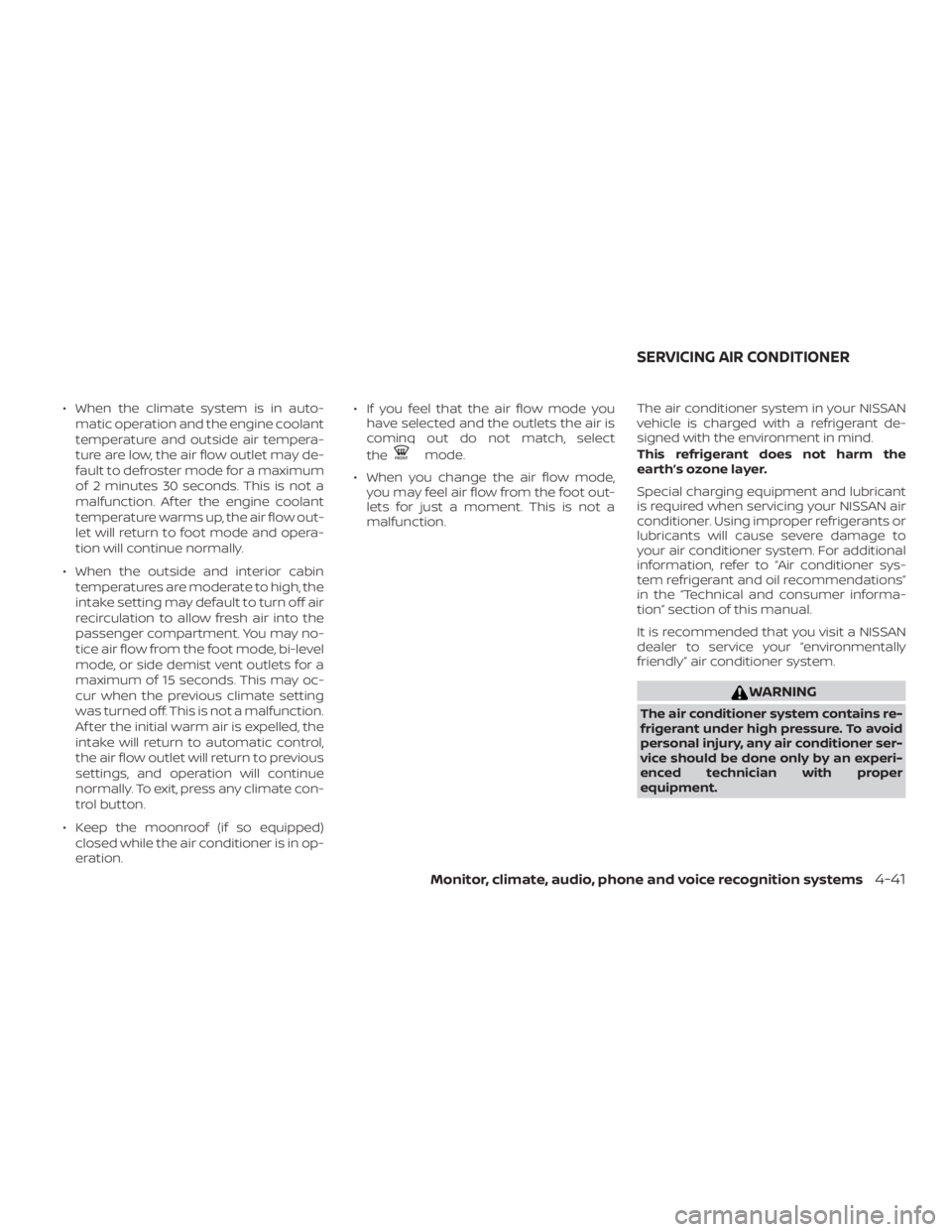
∙ When the climate system is in auto-matic operation and the engine coolant
temperature and outside air tempera-
ture are low, the air flow outlet may de-
fault to defroster mode for a maximum
of 2 minutes 30 seconds. This is not a
malfunction. Af ter the engine coolant
temperature warms up, the air flow out-
let will return to foot mode and opera-
tion will continue normally.
∙ When the outside and interior cabin temperatures are moderate to high, the
intake setting may default to turn off air
recirculation to allow fresh air into the
passenger compartment. You may no-
tice air flow from the foot mode, bi-level
mode, or side demist vent outlets for a
maximum of 15 seconds. This may oc-
cur when the previous climate setting
was turned off. This is not a malfunction.
Af ter the initial warm air is expelled, the
intake will return to automatic control,
the air flow outlet will return to previous
settings, and operation will continue
normally. To exit, press any climate con-
trol button.
∙ Keep the moonroof (if so equipped) closed while the air conditioner is in op-
eration. ∙ If you feel that the air flow mode you
have selected and the outlets the air is
coming out do not match, select
the
Page 259 of 559
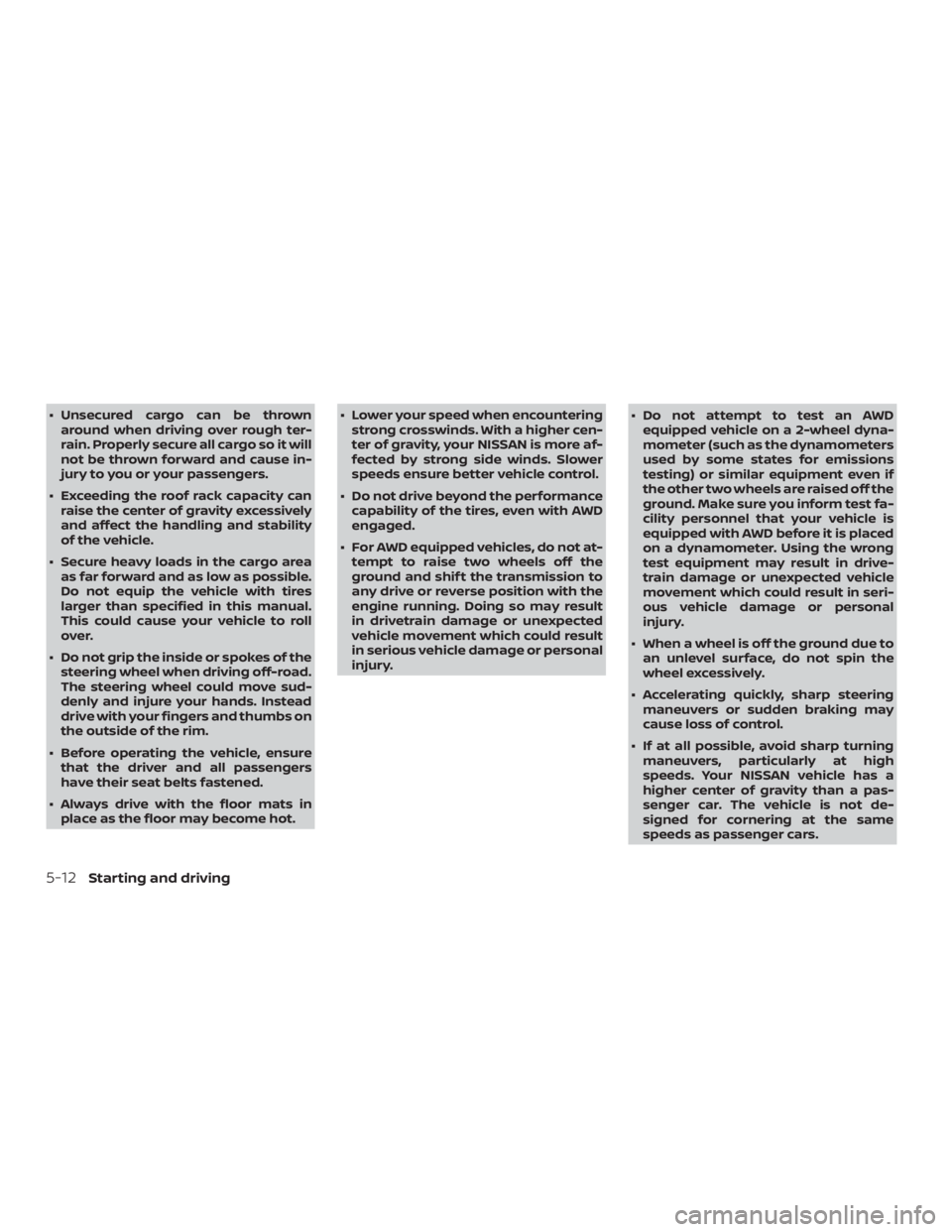
∙ Unsecured cargo can be thrownaround when driving over rough ter-
rain. Properly secure all cargo so it will
not be thrown forward and cause in-
jury to you or your passengers.
∙ Exceeding the roof rack capacity can raise the center of gravity excessively
and affect the handling and stability
of the vehicle.
∙ Secure heavy loads in the cargo area as far forward and as low as possible.
Do not equip the vehicle with tires
larger than specified in this manual.
This could cause your vehicle to roll
over.
∙ Do not grip the inside or spokes of the steering wheel when driving off-road.
The steering wheel could move sud-
denly and injure your hands. Instead
drive with your fingers and thumbs on
the outside of the rim.
∙ Before operating the vehicle, ensure that the driver and all passengers
have their seat belts fastened.
∙ Always drive with the floor mats in place as the floor may become hot. ∙ Lower your speed when encountering
strong crosswinds. With a higher cen-
ter of gravity, your NISSAN is more af-
fected by strong side winds. Slower
speeds ensure better vehicle control.
∙ Do not drive beyond the performance capability of the tires, even with AWD
engaged.
∙ For AWD equipped vehicles, do not at- tempt to raise two wheels off the
ground and shif t the transmission to
any drive or reverse position with the
engine running. Doing so may result
in drivetrain damage or unexpected
vehicle movement which could result
in serious vehicle damage or personal
injury. ∙ Do not attempt to test an AWD
equipped vehicle on a 2-wheel dyna-
mometer (such as the dynamometers
used by some states for emissions
testing) or similar equipment even if
the other two wheels are raised off the
ground. Make sure you inform test fa-
cility personnel that your vehicle is
equipped with AWD before it is placed
on a dynamometer. Using the wrong
test equipment may result in drive-
train damage or unexpected vehicle
movement which could result in seri-
ous vehicle damage or personal
injury.
∙ When a wheel is off the ground due to an unlevel surface, do not spin the
wheel excessively.
∙ Accelerating quickly, sharp steering maneuvers or sudden braking may
cause loss of control.
∙ If at all possible, avoid sharp turning maneuvers, particularly at high
speeds. Your NISSAN vehicle has a
higher center of gravity than a pas-
senger car. The vehicle is not de-
signed for cornering at the same
speeds as passenger cars.
5-12Starting and driving
Page 549 of 559
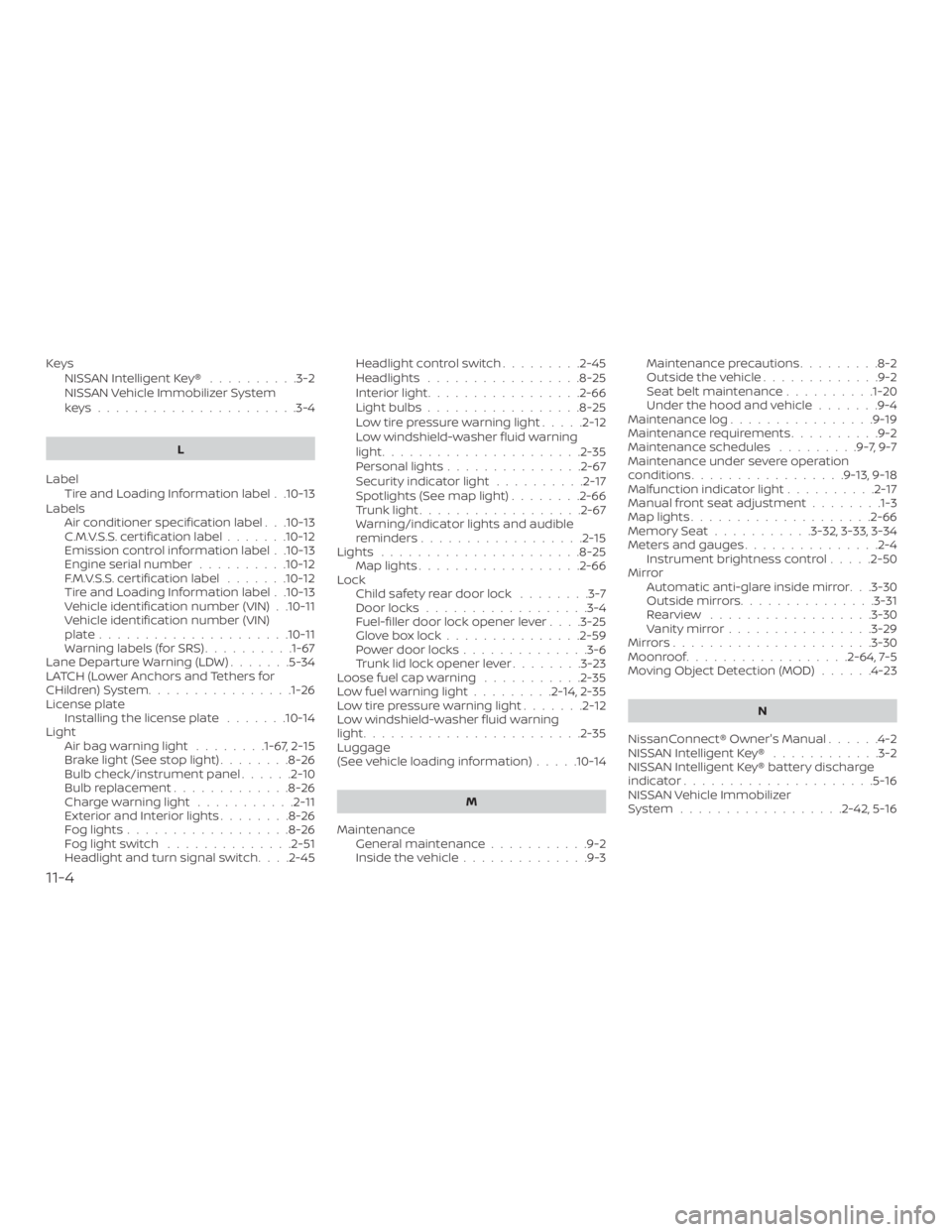
KeysNISSAN Intelligent Key® ..........3-2
NISSAN Vehicle Immobilizer System
keys......................3-4
L
Label Tire and Loading Information label . .10-13
Labels Air conditioner specification label . . .10-13
C.M.V.S.S. certification label .......10-12
Emission control information label . .10-13
Engine serial number ..........10-12
F.M.V.S.S. certification label .......10-12
Tire and Loading Information label . .10-13
Vehicle identification number (VIN) . .10-11
Vehicle identification number (VIN)
plate.....................10-11
Warning labels (for SRS) ..........1-67
Lane Departure Warning (LDW) .......5-34
LATCH (Lower Anchors and Tethers for
CHildren)System............... .1-26
License plate Installing the license plate .......10-14
Light Airbagwarninglight ........1-67, 2-15
Brakelight(Seestoplight)........8-26
Bulb check/instrument panel ......2-10
Bulb replacement .............8-26
Charge warning light ...........2-11
ExteriorandInteriorlights........8-26
Foglights..................8-26
Foglightswitch ..............2-51
Headlight and turn signal switch ....2-45Headlightcontrolswitch.........2-45
Headlights .................8-25
Interiorlight.................2-66
Lightbulbs.................8-25
Low tire pressure warning light
.....2-12
Low windshield-washer fluid warning
light......................2-35
Personal lights ...............2-67
Security indicator light ..........2-17
Spotlights(Seemaplight)........2-66
Trunklight..................2-67
Warning/indicator lights and audible
reminders ..................2-15
Lights ......................8-25 Maplights..................2-66
Lock Child safety rear door lock ........3-7
Door locks ..................3-4
Fuel-filler door lock opener lever ....3-25
Gloveboxlock...............2-59
Power door locks ..............3-6
Trunk lid lock opener lever ........3-23
Loose fuel cap warning ...........2-35
Lowfuelwarninglight.........2-14,2-35
Low tire pressure warning light .......2-12
Low windshield-washer fluid warning
light........................2-35
Luggage
(See vehicle loading information) .....10-14
M
Maintenance General maintenance ...........9-2
Insidethevehicle..............9-3 Maintenance precautions
.........8-2
Outsidethevehicle.............9-2
Seat belt maintenance ..........1-20
Under the hood and vehicle .......9-4
Maintenance log ................9-19
Maintenance requirements ..........9-2
Maintenance schedules .........9-7,9-7
Maintenance under severe operation
conditions.................9-13,9-18
Malfunctionindicatorlight..........2-17
Manual front seat adjustment ........1-3
Maplights................... .2-66
Memory Seat ...........3-32,3-33,3-34
Meters and gauges ...............2-4
Instrument brightness control .....2-50
Mirror Automatic anti-glare inside mirror. . .3-30
Outsidemirrors...............3-31
Rearview ..................3-30
Vanitymirror................3-29
Mirrors......................3-30
Moonroof ..................2-64,7-5
Moving Object Detection (MOD) ......4-23
N
NissanConnect® Owner's Manual ......
4-2
NISSAN Intelligent Key® ............3-2
NISSAN Intelligent Key® battery discharge
indicator.................... .5-16
NISSAN Vehicle Immobilizer
System..................2-42, 5-16
11-4
Page 551 of 559
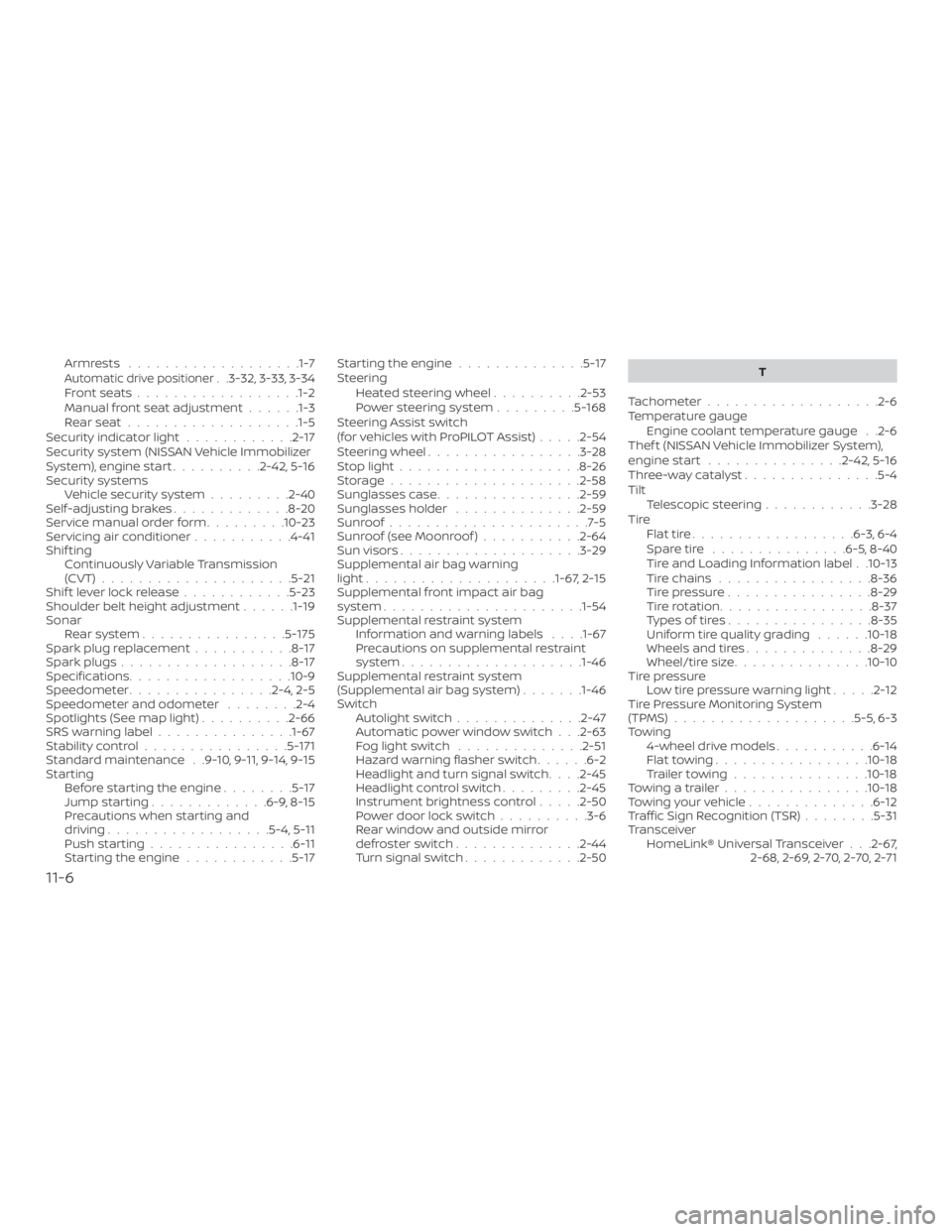
Armrests ...................1-7Automatic drive positioner. .3-32, 3-33, 3-34
Frontseats..................1-2
Manual front seat adjustment ......1-3
Rearseat...................1-5
Security indicator light ............2-17
Security system (NISSAN Vehicle Immobilizer
System), engine start ..........2-42,5-16
Security systems Vehicle security system .........2-40
Self-adjustingbrakes.............8-20
Service manual order form .........10-23
Servicing air conditioner ...........4-41
Shif ting Continuously Variable Transmission
(CVT) .....................5-21
Shiftleverlockrelease............5-23
Shoulder belt height adjustment ......1-19
Sonar Rear system ................5-175
Spark plug replacement ...........8-17
Spark plugs ...................8-17
Specifications ..................10-9
Speedometer ................2-4,2-5
Speedometer and odometer ........2-4
Spotlights(Seemaplight)..........2-66
SRS warning label ...............1-67
Stability control ................5-171
Standard maintenance . .9-10, 9-11, 9-14, 9-15
Starting Before starting the engine ........5-17
Jumpstarting.............6-9,8-15
Precautions when starting and
driving ..................5-4,5-11
Push starting ................6-11
Starting the engine ............5-17 Starting the engine
..............5-17
Steering Heated steering wheel ..........2-53
Powersteeringsystem.........5-168
Steering Assist switch
(forvehicleswithProPILOTAssist).....2-54
Steering wheel .................3-28
Stoplight....................8-26
Storage.....................2-58
Sunglasses case ................2-59
Sunglasses holder ..............2-59
Sunroof ......................7-5
Sunroof (see Moonroof ) ...........2-64
Sunvisors....................3-29
Supplemental air bag warning
light.................... .1-67, 2-15
Supplemental front impact air bag
system ..................... .1-54
Supplemental restraint system Information and warning labels . . . .1-67
Precautions on supplemental restraint
system ................... .1-46
Supplemental restraint system
(Supplemental air bag system) .......1-46
Switch Autolightswitch..............2-47
Automatic power window switch . . .2-63
Foglightswitch ..............2-51
Hazard warning flasher switch ......6-2
Headlight and turn signal switch ....2-45
Headlightcontrolswitch.........2-45
Instrument brightness control .....2-50
Power door lock switch ..........3-6
Rear window and outside mirror
defrosterswitch..............2-44
Turn signal switch .............2-50 T
Tachometer ...................2-6
Temperature gauge Engine coolant temperature gauge . .2-6
Thef t (NISSAN Vehicle Immobilizer System),
engine start ...............2-42,5-16
Three-waycatalyst...............5-4
Tilt T
elescopicsteering............3-28
Tire Flattire..................6-3,6-4
Spare tire ...............6-5,8-40
Tire and Loading Information label . .10-13
Tire chains .................8-36
Tire pressure ................8-29
Tirerotation.................8-37
Types of tires ................8-35
Uniform tire quality grading ......10-18
Wheels and tires ..............8-29
Wheel/tire size ...............10-10
Tire pressure Low tire pressure warning light .....2-12
Tire Pressure Monitoring System
(TPMS)....................5-5,6-3
Towing 4-wheel drive models ...........6-14
Flattowing.................10-18
Trailertowing...............10-18
Towingatrailer................10-18
Towingyourvehicle..............6-12
Traffic Sign Recognition (TSR) ........5-31
Transceiver HomeLink® Universal Transceiver . . .2-67, 2-68, 2-69, 2-70, 2-70, 2-71
11-6